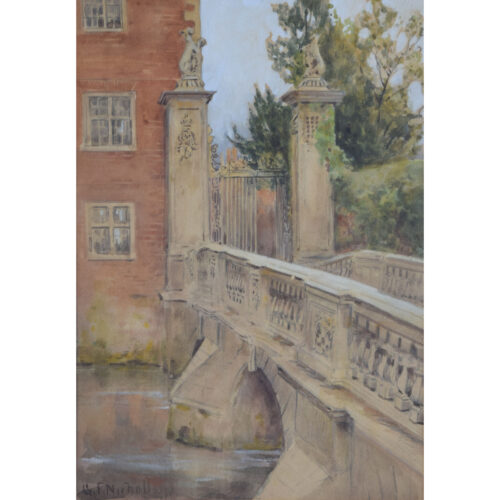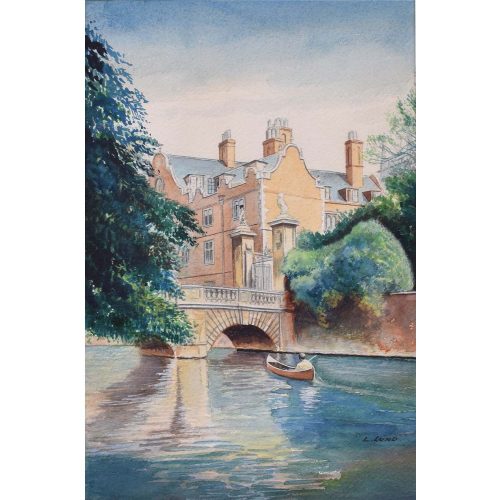-
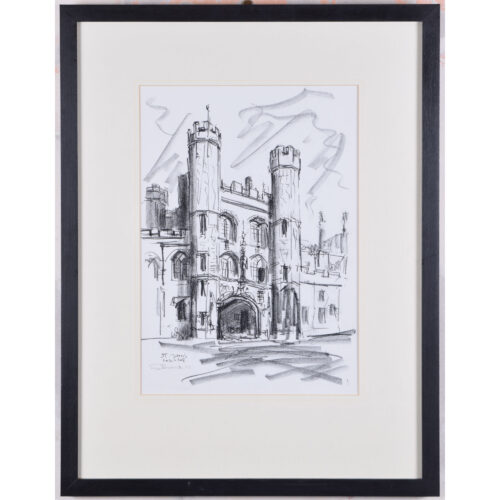
Tony Broderick (late 20th century)
St John's College, Cambridge Great Gate
Conte 38 x 27 cm Signed and dated in pencil lower left. A Lincoln-based artist known for his pictures of Lincoln and also of Cambridge's colleges. Condition: very good. If you are interested, please email info@manningfineart.co.uk or call us on 07929 749056. Click here for other views of St John’s College, Cambridge. -
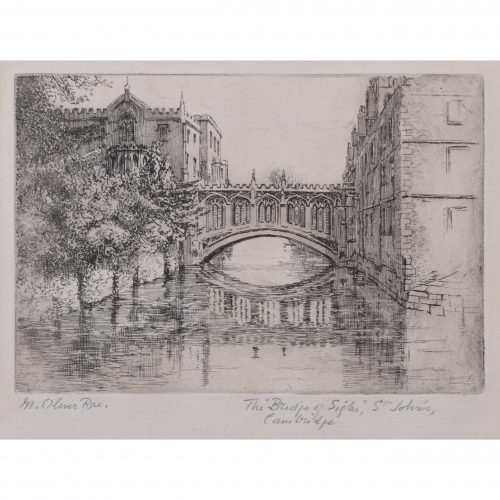
Mabel Oliver Rae (1868 - 1956)
The Bridge of Sighs, St John's College, Cambridge (circa 1920)
Etching 13 x 18 cm Hand-signed in pencil lower left, and titled in pencil lower right. Initialled 'MR' in plate lower left. The Bridge of Sighs is an iconic feature of St John’s College, and one of the most recognisable pieces of architecture in Cambridge. It was built in 1831 by the architect Henry Hutchinson and crosses the River Cam between the college's Third Court and New Court. It is the only covered bridge to cross the River Cam, and the only College bridge built in the Victorian Gothic style. Mabel Oliver Rae was born in Cambridge, Cambridgeshire, and trained at the Slade School of Fine Art between 1888 and 1890. Rae is known for her skilled etchings of various rural scenes and townscapes, particularly those of the colleges of Oxford and Cambridge. She signed works with the pseudonym 'M.Oliver Rae', a ruse to conceal the fact she was a female artist, so as not to reduce her chances with commercial dealers and agents. Condition: even age toning, a little spotting, generally good. If you’d like to know more, please email info@manningfineart.co.uk or call us on 07929 749056. -
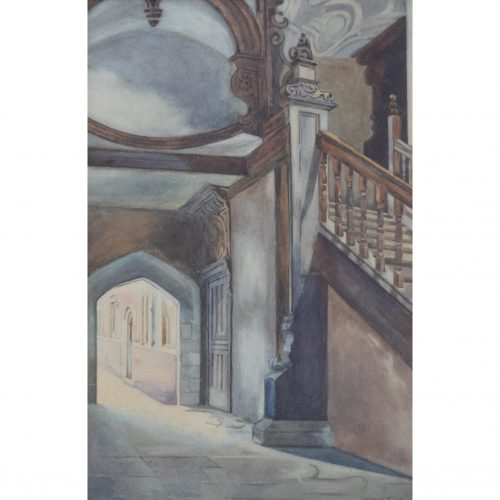
After Ernest William Haslehurst (1866 - 1949)
E Staircase, Second Court, St John's College, Cambridge (circa 1915)
Watercolour 33 x 22 cm Haslehurst's watercolour of a staircase at John's. The artists captures the quintessential Cambridge combination of dark wood and old stone, focusing on a beautiful but overlooked passageway in the college. Light streams in from the court. Second Court was built in the years immediately after 1599, to the designs of Ralph Symons of Westminster and Gilbert Wigg of Cambridge. The harmonious proportions and local brickwork of the Court in general make it the finest example of this style of architecture in Cambridge. Ernest William Haslehust was an English landscape painter and book illustrator who worked in watercolours. He was a member of the Royal Institute of Painters in Water Colours (RI), Royal Society of British Artists (RBA), Royal West of England Academy (RWA) and Royal British Colonial Society of Artists (RBC), and exhibited regularly at many venues including the Royal Academy in London. He also designed posters for the LNER and LMS railway companies, and his art was featured in many magazines of the day including the Illustrated London News and The Tatler. His painting of this view was featured in the illustrated book of Cambridge by Noel Barwell (Blackie & Son) 1910, and the artist of this painting has recorded the view from the same corner. Condition: very good; some light spotting. Handsome antique frame which bears some signs of age. If you’d like to know more, please email info@manningfineart.co.uk or call us on 07929 749056. -
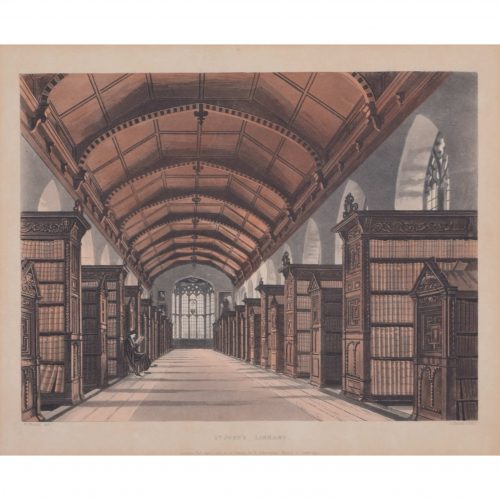
D Havell (1785 - 1822) after William Westall (1781 - 1850)
The Library of St John's College, Cambridge (1815)
Hand-coloured aquatint 24 x 29.5 cm Published by Rudolph Ackermann (1764 - 1834). An engraving of St John's College, Cambridge's marvellous library. It was built between 1623 and 1628, largely through the donations and efforts of two members of the college: Valentine Carey, Bishop of Exeter, and John Williams, Lord-Keeper and Bishop of Lincoln. The building's shell was completed in 1624, a date which appears on the south gable of the western oriel window. The building is constructed in the Jacobean Gothic style, and measures 110 feet by 30 feet wide. The tall two-light windows are a very early example of Gothic Revival, but the façade is Renaissance-inspired. The library contains 42 bookcases arranged at right angles to the north and south walls, and is the home of the College's double-manual harpsichord. William Westall was a British landscape artist. He was born in Hertford and enrolled at the Royal Academy schools in 1799. He later became the draughtsman for a voyage to Australia and the South Seas. After being shipwrecked, he travelled to Canton in China and to India, staying in Bombay for several months. He returned to England in 1805 but later set off for Madeira and Jamaica. He became a member of the Society of Painters in Water Colours (1811) and an associate of the Academy (1812). Following a mental breakdown, he regularly visited the Lake District and published ‘Views of the Valley and Vale of Keswick’ (1820). His series of aquatints of the Thames, the great universities, and England''s public schools for Ackermann are among his most popular works. The Havell family of Reading, Berkshire, England, included a number of notable engravers, etchers and painters, as well as writers, publishers, educators, and musicians. Daniel and Robert Havell set up in partnership as aquatint engravers. Soon Daniel began to work independently, engraving plates for Rudolph Ackermann''s History of Cambridge (1815) and hid history of various public schools including Eton, Winchester, and Rugby (1816), as well as a celebrated views of St Paul''s Cathedral (1818) and various other London landmarks for Ackermann''s Repository of Arts. Rudolph Ackermann was an Anglo-German bookseller, inventor, lithographer, publisher and businessman. In 1795 he established a print-shop and drawing-school at 96 Strand. Here Ackermann set up a lithographic press and began a trade in prints. He later began to manufacture colours and thick carton paper for landscape and miniature painters. Within three years the premises had become too small and he moved to 101 Strand, in his own words "four doors nearer to Somerset House", the seat of the Royal Academy of Arts. Between 1797 and 1800 Ackermann rapidly developed his print and book publishing business, encompassing many different genres including topography, caricature, portraits, transparencies and decorative prints. Condition: good. Some age toning. If you’d like to know more, please email info@manningfineart.co.uk or call us on 07929 749056. -
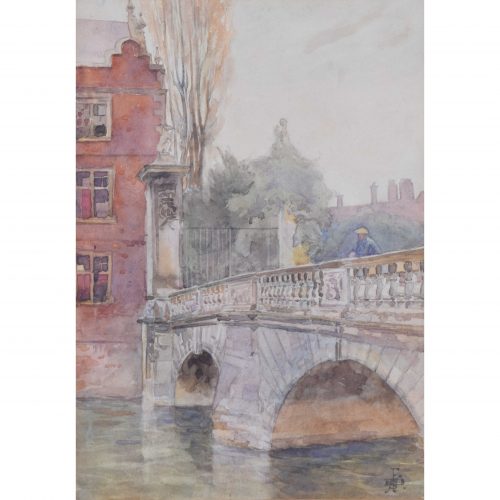
The Wren Bridge, St John's College, Cambridge
Engraving 35 x 24 cm Signed as a cypher lower right. A 1911 watercolour of St John's College's Wren Bridge, also known as the Kitchen Bridge. There had been a wooden bridge in this location since the early days of the medieval Hospital of St John the Evangelist. Christopher Wren had submitted designs to St John’s for a stone bridge in the 1690s, but building work did not commence until 1709. The Wren Bridge was completed in 1713. Its construction was overseen by Robert Grumbold, a local master stonemason and architect who was also responsible for building the Wren Library at Trinity College. The bridge reflects Wren's design, although in his original drawings he had suggested urns and pyramids, which were never added. In this view, a lone figure gazes down from the bridge into the muddy waters of the River Cam. Condition: very good. If you’d like to know more, please email info@manningfineart.co.uk or call us on 07929 749056. -

John Stanton Ward CBE (1917 - 2007)
St John's College, Cambridge
Watercolour 30 x 47 cm John Stanton Ward CBE was an English portrait artist, landscape painter and illustrator. This view of St John's highlights the dreamlike quality of the college and its city. Ward depicts Cambridge on a winter afternoon; the trees are bare, and the afternoon sun sets gently over the city's lawns and high spires. Condition: very good. -
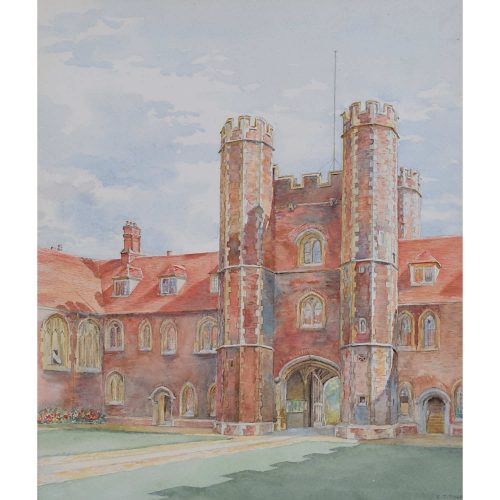
E. T. Talbot
St John's College, Cambridge, showing the First Court and Chapel
Watercolour 30 x 25 cm A richly-coloured watercolour painting of the First Court of St John's. First Court was built in 1511-20 to the south of the old Hospital of St John the Evangelist, and was designed to contain living quarters, chapel, library, hall, and kitchens. The version of First Court which Talbot paints looks markedly different to the college today - the chapel on the far left of the picture was demolished after the new chapel was completed in 1869. -
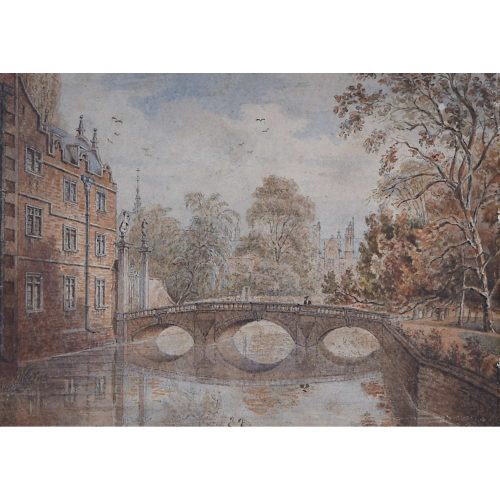
Sarah Orange (19th century)
The Kitchen Bridge, St John's College, Cambridge (c. 1830)
Watercolour 14 x 20 cm Provenance: Bene't Gallery, Cambridge. This 19th century watercolour depicts the Kitchen Bridge at John's. A scholar in gown and mortarboard stands alone in the bridge's centre, gazing meditatively into the glassy water below. -
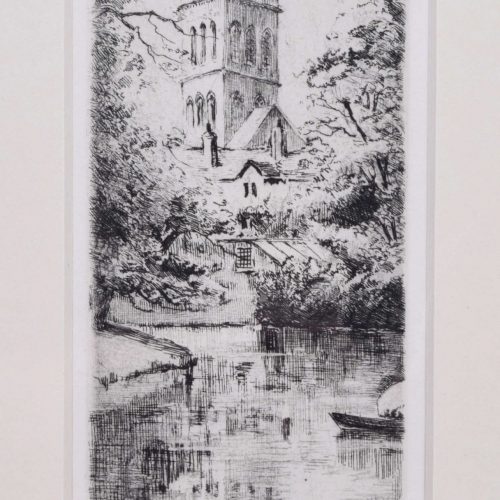
Mabel Oliver Rae
Chapel Tower of St John's College, Cambridge
Etching, circa 1920 19 x 7 cm Hand-signed in pencil lower left, and titled in pencil lower right. Signed "MR" in plate. Mabel Oliver Rae was born in Cambridge, Cambridgeshire, and trained at the Slade School of Fine Art between 1888 and 1890. Rae is known for her skilled etchings of various rural scenes and townscapes, particularly those of the colleges of Oxford and Cambridge. She signed works with the pseudonym 'M.Oliver Rae', a ruse to conceal the fact she was a female artist, so as not to reduce her chances with commercial dealers and agents. Condition: Generally very good. -
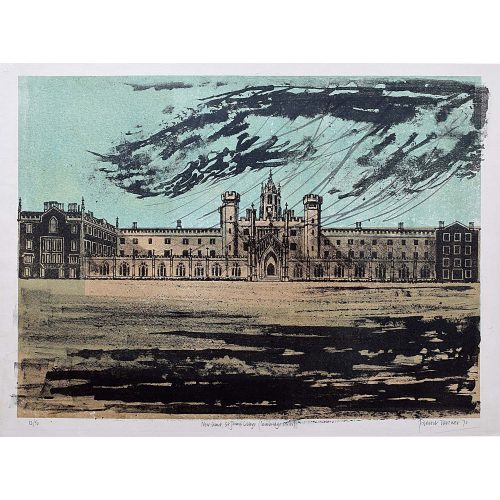
Robert Tavener (1920-2004) New Court St John's College Cambridge
Signed and numbered 12/50 Lithograph 40×52 cm c. 1970 For other works by Robert Tavener and biographical details click here. If you are interested email info@manningfineart.co.uk or call us on 07929 749056. Condition: Good. -

James Bolivar Manson (1879 - 1945) St John's College, Cambridge
Watercolour 29 x 40 cm Signed lower right. A wintry view of St John's College, Cambridge. The chapel tower nestles behind bare trees, set against a white sky. Manson was an artist who worked at the Tate Gallery and was its Director from 1930 to 1938. His time there was clouded by his frustrated ambitions as a painter and his descent into alcoholism. His professional career began as an office boy - leaving Alleyn's School in Dulwich at 16 - with the publisher George Newnes, and then as a bank clerk. He simultaneously studied painting at Heatherley School of Fine Art, commencing in 1890, and then Lambeth School of Art - much encouraged by Lilian Laugher, a violinist who came to stay in the Manson household. He married her in 1903 - the same year he abandoned his bank job. They moved to Paris for a year. Manson shared a studio with Jacob Epstein, who became a lifelong friend. When they returned to London, Manson joined the Camden Town Group, becoming Secretary. Lilian was a close friend of the Director of the Tate and ensured that Manson, aged 33, became Tate Clerk. Manson continued to paint feverishly at the weekend. The Tate website describes Manson as its 'least succesful' director. Kenneth Clark described him with "a flushed face, white hair and a twinkle in his eye; and this twinkling got him out of scrapes that would have sunk a worthier man without trace." His painting continued to show promise, and he joined the London Group in 1914 and showed with the New England Art Club from 1915. His first solo show was at the Leicester Galleries in 1923 and he became a member of the NEAC in 1927. He attended a dinner at the Hotel George V in Paris in 1938 to celebrate the British Exhibition at the Louvre. Clive Bell wrote to his wife, "Manson arrived at the déjeuner given by the minister of Beaux Arts fantastically drunk - punctuated the ceremony with cat-calls and cock-a-doodle-doos, and finally staggered to his feet, hurled obscene insults at the company in general and the minister in particular, and precipitated himself on the ambassadress, Lady Phipps, some say with amorous intent; others with lethal intent." Bell concluded: "The guests fled, ices uneaten, coffee undrunk... I hope an example will be made, and that they will seize the opportunity for turning the sot out of the Tate, not because he is a sot, but because he has done nothing but harm to modern painting." The Director of the Tate was arbiter as to whether imported items amounted to art (which would make them exempt from customs duty). This caused controversy when Peggy Guggenheim imported sculpture by Marcel Duchamp and others. Manson pronounced Constantin Brâncuși's Sculpture for the Blind (a large, smooth, egg-shaped marble) to be "idiotic" and "not art", and therefore subject to duty. Letters were written to the press and the matter reached the House of Commons, where Manson was criticised and eventually had to back down. He retired at the age of 58. By his own account, "my doctor has warned me that my nerves will not stand any further strain... I have begun to have blackouts, in which my actions become automatic. Sometimes these periods last several hours.... I had one of these blackouts at an official luncheon in Paris recently, and startled guests by suddenly crowing like a cock...." His successor was Sir John Rothenstein, who discovered that the staff referred to artwork in the basement as 'Director's Stock'. It transpired that Manson had been selling it to boost his salary. His work now hangs in the Tate, as well as in many other galleries in Britain and abroad. Condition: Good. If you’d like to know more, please email info@manningfineart.co.uk or call us on 07929 749056. Click here for more views of St John's College, Cambridge. -

Anonymous St. John’s College, Cambridge
Watercolour 32x24.5cm If you are interested email info@manningfineart.co.ukor call us on 07929 749056. Condition: Good. -
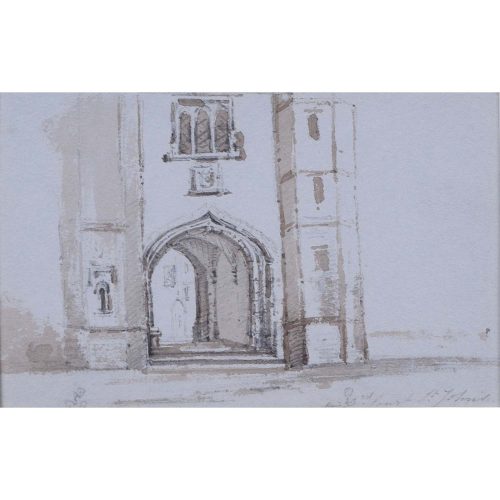
Marianne James
Entrance to Third Court St. John’s College Cambridge (c.1810-1860)
Watercolour & pencil Signed 10×17cm If you are interested email info@manningfineart.co.uk or call us on 07929 749056. Condition: Good. -
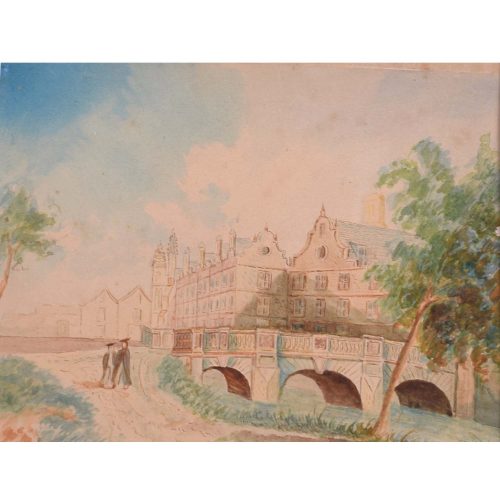
Anonymous
St John’s College, Cambridge
Watercolour and pencil 13x18cm Probably early 19th century. This watercolour depicts St John’s prior to construction of Hutchinson’s 1831 New Court buildings; two figures wearing gowns and square caps are engaged in conversation by the Wren Bridge. If you are interested email info@manningfineart.co.uk or call us on 07929 749056. Condition: Good. -
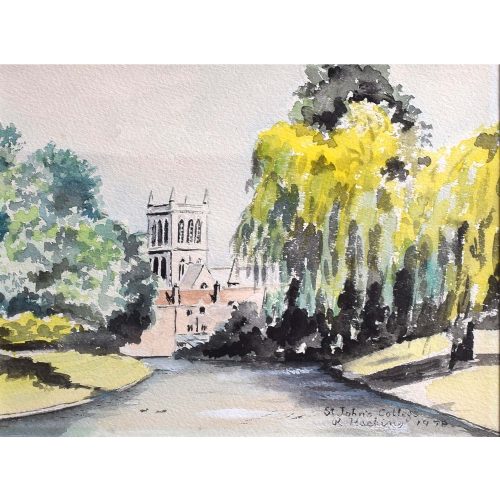
R Hacking
St. John’s College, Cambridge (1978)
Watercolour 17x25cm If you are interested email info@manningfineart.co.ukor call us on 07929 749056. Condition: Good. -
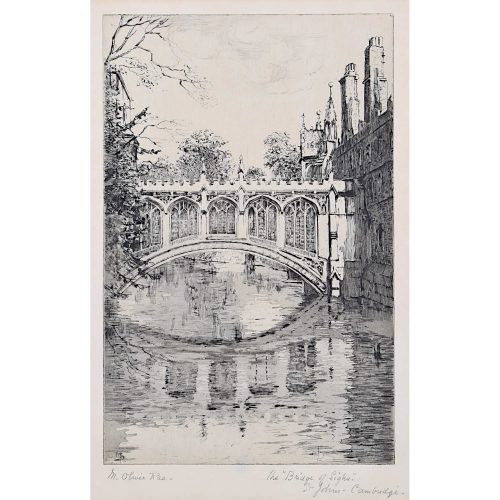
Mabel Oliver Rae (1868-1956) Bridge of Sighs St John's College Cambridge
Etching 30x19 cm Click here for biographical details and other pictures by the artist. If you are interested email info@manningfineart.co.uk or call us on 07929 749056. Condition: Good. -
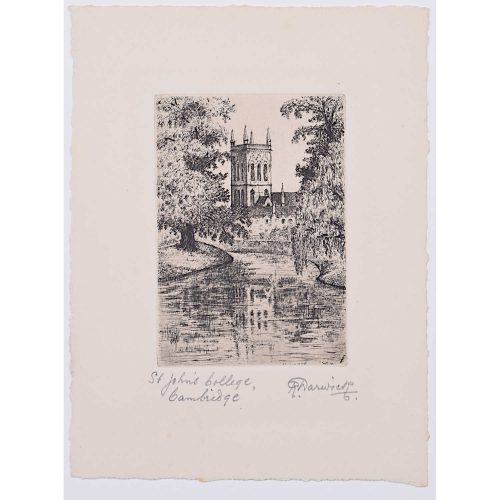
R Warwick (British, fl c. 1900-1930) St John's College Cambridge
Etching size: 9x6cm; sheet size 15x12cm On deckle-edged paper If you are interested email info@manningfineart.co.uk or call us on 07929 749056. Condition: Generally very good condition. -
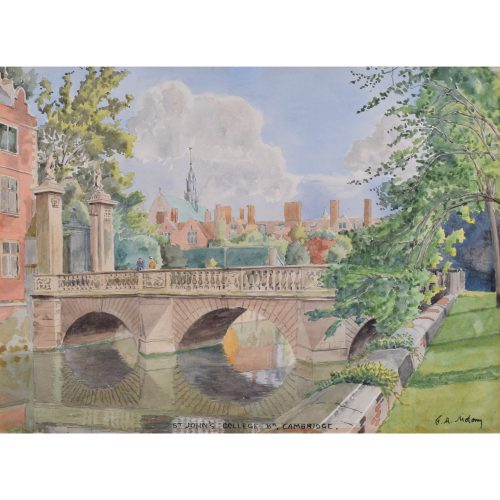
Major F A Molony (c. 1865 - ?) St John's College, Cambridge
watercolour, probably early twentieth century 7x10" Molony was member of the Royal Engineers and a talented watercolourist. 25 July 1882: Promoted to the rank of Lieutenant. 1885: Served in the 10th Company, Royal Engineers during the Suakin Expedition. 22 October 1890: Promoted to the rank of Captain. 27 October 1899: Promoted to the rank of Major. Fought at Battle of Pieters Hill, in the Anglo-Boer war. 23 June 1902: Mentioned in Lord Kitchener's Despatches.m, If you are interested email info@manningfineart.co.uk or call us on 07929 749056. Condition: Good. -

Rowland de Winton Aldridge (1906-1997) The Backs, St John's College Cambridge
34x51cm watercolour Born in Kent he was given 'de Winton' after his grandmother, who was related to the De Wintons of the Welsh engineering company De Winton & Co (1854-1901) that built narrow-gauge railways. He was a protégé of Edward Wesson, one of Britian's most important twentieth century watercolourists, and was a prolific artist of landscapes and urban riverscapes. St John's College Cambridge was one of his favourite views to paint, combining as it does an urban riverscape, a landscape and late 17th century buildings. Aldridge was an authority on 18th century architecture and was adviser to Baron Iliffe during his restoration of Basildon Park. If you are interested email info@manningfineart.co.ukor call us on 07929 749056. Condition: Good. -
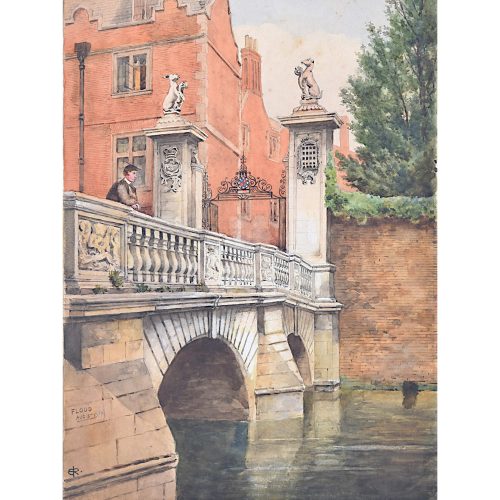
'ER' Monogrammist St John's College Cambridge, the Wren Bridge from the River Cam
Watercolour c. 1900 35x25cm A highly accomplished watercolour of the Kitchen Bridge at St John's College. The artist has clearly had a change of heart, and visibly moved the person standing on the bridge, bringing a sense of movement to what is otherwise a still painting. Moreover the richness of the colour he has chosen for the brickwork brings a further element of surprise to the viewer. If you are interested email info@manningfineart.co.uk or call us on 07929 749056. Condition: Mounted to board, the occasional tiny spot to the sky as visible in photograph. -
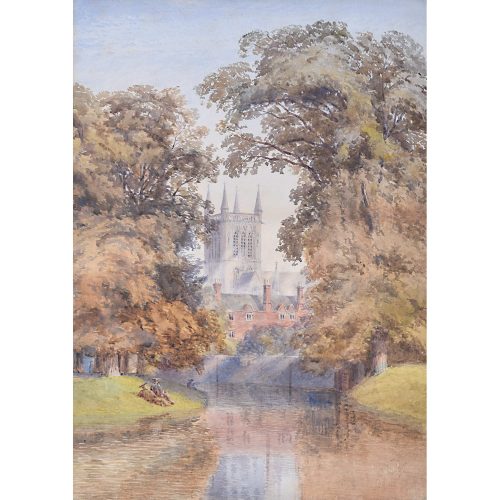
Anonymous (British, c. 1900) St John's College Cambridge from the River, Scholars Before
39x28cm Watercolour Scholars loll on the bank of the River Cam as they do today, and presumably have done ever since the foundation of the college in 1511. A dreamy view of one of the prettiest views in Cambridge. Condition: generally very good, slight staining to very margins, outside mount area. -
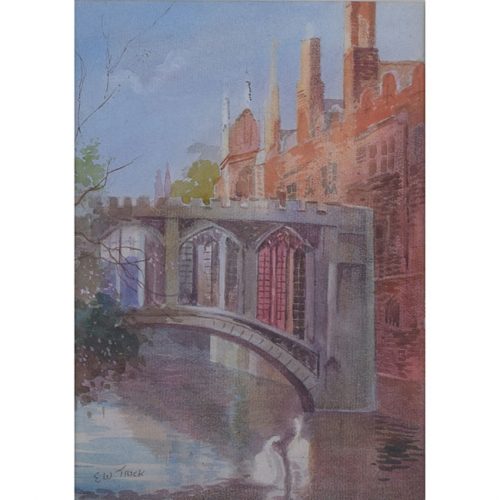
E W Trick
Bridge of Sighs, St. John's College, Cambridge
Watercolour 24x18cm If you are interested email info@manningfineart.co.uk or call us on 07929 749056. -
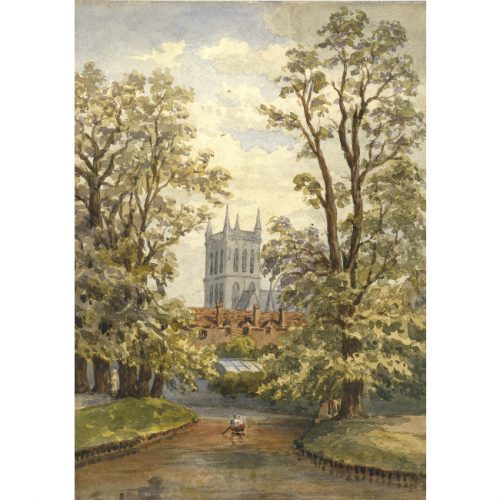
St. John’s College Chapel Cambridge (1895)
Watercolour 34×24.5cm Click to see King’s College by the same hand. If you are interested email info@manningfineart.co.uk or call us on 07929 749056. -
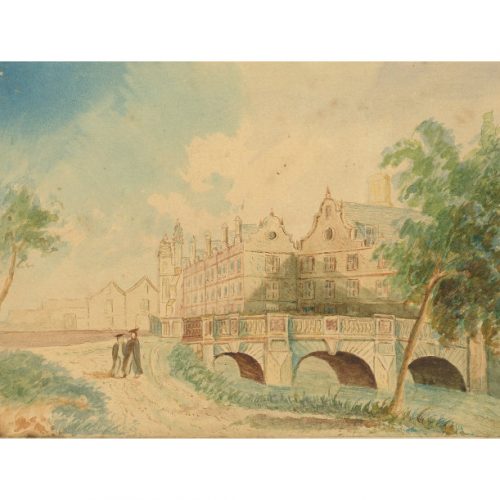
St John’s College, Cambridge
Watercolour and pencil 13x18cm Probably early 19th century. This watercolour depicts St John's prior to construction of Hutchinson's 1831 New Court buildings; two figures wearing gowns and square caps are engaged in conversation by the Wren Bridge. If you are interested email info@manningfineart.co.uk or call us on 07929 749056. -
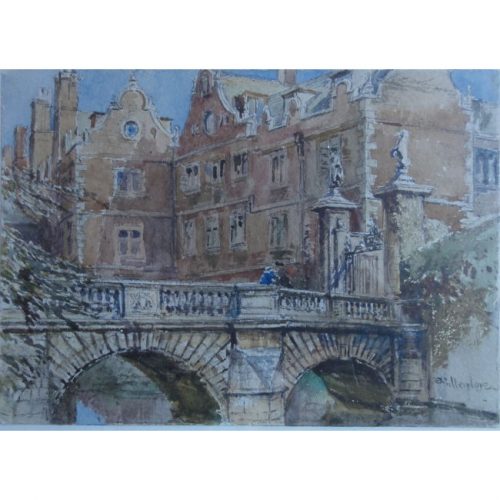 John Fulleylove (1845-1908) The Kitchen Bridge, St John’s College, Cambridge Signed lower right “Fulleylove” Watercolour 13 x 19cm (5 x 7 inches) Please click here for the matching watercolour of the Old Library together with biographical details and other works by the artist. If you are interested email info@manningfineart.co.uk or call us on 07929 749056.
John Fulleylove (1845-1908) The Kitchen Bridge, St John’s College, Cambridge Signed lower right “Fulleylove” Watercolour 13 x 19cm (5 x 7 inches) Please click here for the matching watercolour of the Old Library together with biographical details and other works by the artist. If you are interested email info@manningfineart.co.uk or call us on 07929 749056. -
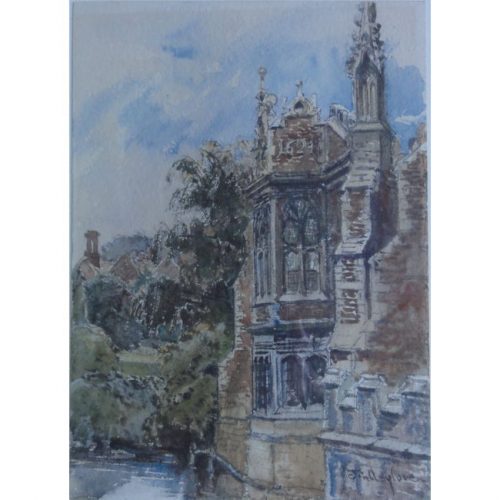
John Fulleylove (1845-1908)
The Old Library, St John’s College, Cambridge
Signed lower right “Fulleylove” Watercolour 19x13cm (7×5 inches) Please click here for the matching watercolour of the Kitchen Bridge together with biographical details and other works by the artist. If you are interested email info@manningfineart.co.uk or call us on 07929 749056. -
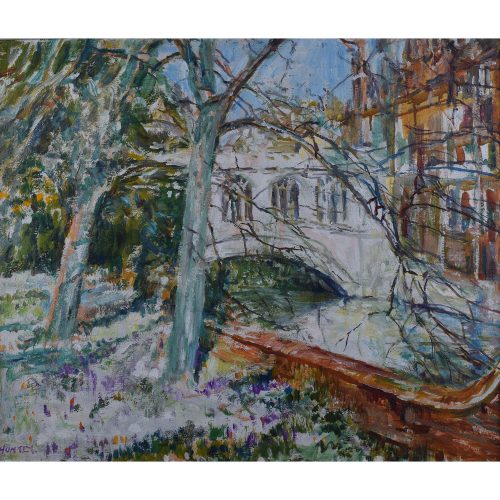
Nancy Weir Huntly (1890-1963)
St John's College Bridge of Sighs Cambridge
Oil on canvas; framed. Signed 'Huntly' 50x61cm Born in India, in Nusserabad, she studied art at the Royal Academy Schools in Dusseldorf. She lived in Welwyn Garden City, in Hertfordshire, with her daughter, Faith Sheppard, also a painter. She also painted under the name Nancy Sheppard. If you are interested email info@manningfineart.co.uk or call us on 07929 749056. -
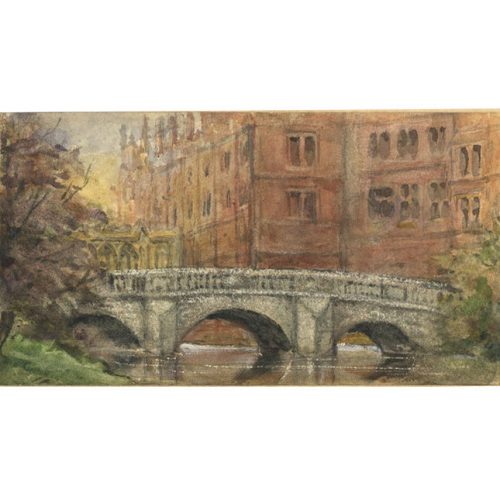
Anonymous
Wren Bridge St. John’s College Cambridge
Watercolour and pencil 8.8×16.7cm A charmingly painted watercolour c. last quarter 19th century If you are interested email info@manningfineart.co.ukor call us on 07929 749056. Condition: Good. -

Edwin La Dell ARA (1914-1970)
St John's College Cambridge
Signed and titled Lithograph (1959)35x46.5cm
Click here for biographical details and other works by the artist. If you are interested email info@manningfineart.co.ukor call us on 07929 749056. Condition: Good. -

Tony Broderick
St. John's Great Gate, Cambridge
Conte drawing 33x42cm If you are interested email info@manningfineart.co.uk or call us on 07929 749056. -
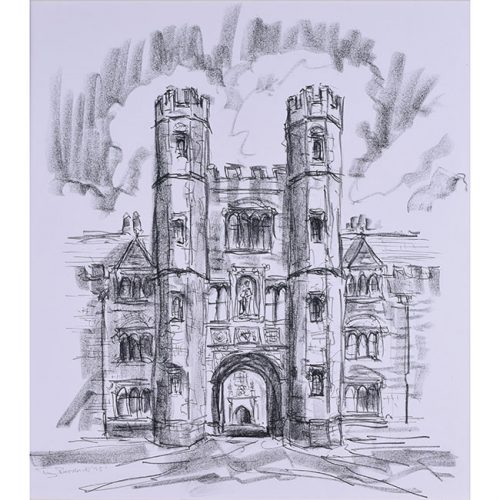
Tony Broderick
Shrewsbury Tower St. John's College Cambridge
Conte drawing 35x32cm If you are interested email info@manningfineart.co.uk or call us on 07929 749056. -
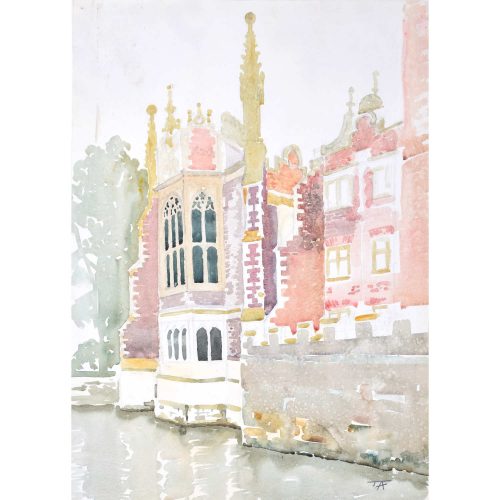
J V C Anthony (British, 20th Century)
St. John's College, Cambridge
Watercolour 55 x 37 cm (21.5 x 14.5 in.) Anthony exhibited with the Society of Marine Artists and painted a number of views of Cambridge. Click here to see other works by him. If you are interested email info@manningfineart.co.uk or call us on 07929 749056. -
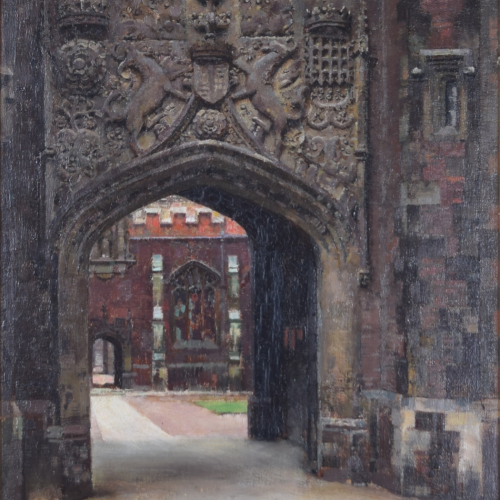
William Logsdail (1859-1944)
St John's College Cambridge, Great Gate
Oil on board 39 x 28 cm Signed lower right. In an original 19th century gilt composition frame. Provenance: the private collection of the late Christopher Wood, a renowned dealer in Victorian art who was a member of St John’s. If you are interested, please email info@manningfineart.co.uk or call us on 07929 749056. -
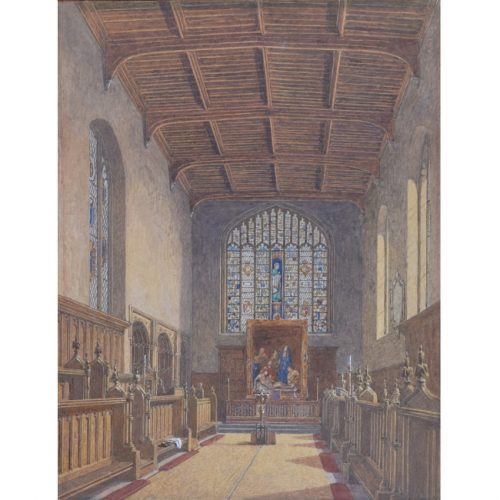
George Pyne (1800 - 1884)
St John's College, Cambridge Old Chapel
Watercolour 35 x 23 cm A view of the Old Chapel of St John’s College, Cambridge before its demolition. In 1861, the Fellows of St John’s agreed to mark the seven hundredth jubilee of their college by building a new chapel. Sir George Gilbert Scott was appointed to carry out the work, and Dr James Wood (a previous Master of the college) bequeathed the huge sum of £20,000 for the purpose of the new chapel. George Pyne was related to two founders of the Society of Painters in Watercolours – William Henry Pyne was his father, and John Varley his father-in-law. Pyne trained as an architectural draughtsman and lived in Oxford from the 1850s until his death in 1884, specialising in views of the city and its colleges. His Oxford pictures are both architecturally-minded and romantically creative, often combining intensely detailed depictions of college buildings with imagined pedestrian scenes. Pyne was also noted for his views of Cambridge and Eton, and for his drawing manuals ‘A Rudimentary and Practical Treatise on Perspective for Beginners’ (1848) and ‘Practical Rules on Drawing for the Operative Builder, and Young Student in Architecture’ (1854); the latter texts offer an insight into his method of depicting architecture and its surroundings. Condition: very good. If you are interested, please email info@manningfineart.co.uk or call us on 07929 749056. Click here for other views of St John's College, Cambridge.

